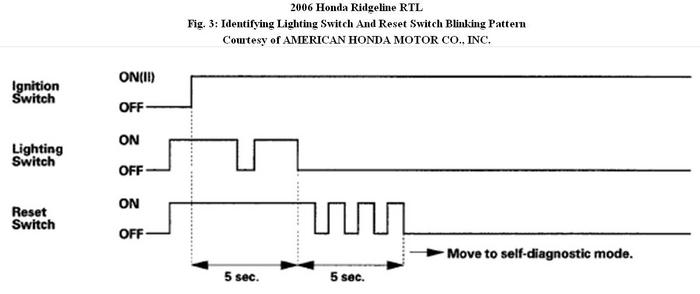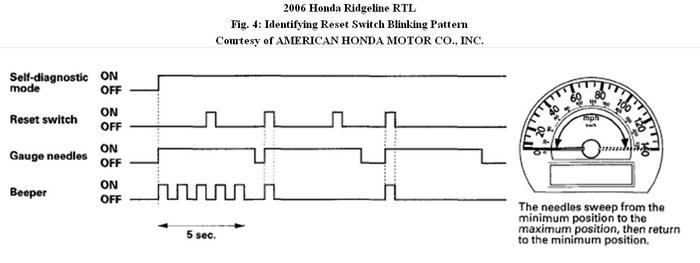The impact damage could have caused some wiring damages and that can cause malfunctions with components related to the Multiplex control System, of which the gauges are part of it.
See if the following helps.
SELF-DIAGNOSTIC FUNCTION
Before troubleshooting the gauge system, refer to multiplex integrated control system B-CAN System Diagnosis Test Mode A (see TROUBLESHOOTING - B-CAN SYSTEM DIAGNOSIS TEST MODE A ).
The gauge control module has a self-diagnostic function shown.
†The beeper drive circuit check.
†The indicator drive circuit check.
†The switch input test.
†The LCD segments check.
†The gauges drive circuit check (Speedometer, Tachometer, Fuel gauge, Coolant temperature gauge).
†The communication line check (of the body-controller area network (B-CAN) communication line and the fast-controller area network (F-CAN) communication line between the gauges).
NOTE: Indicators are also controlled via the communication line.
ENTERING THE SELF-DIAGNOSTIC FUNCTION
Before doing the self-diagnostic function, check the No. 7 (7.5 A) fuse, the No. 21 (7.5 A) fuse and the No. 32 (7.5 A) in the under-dash fuse/relay box.
1. Push and hold the RESET switch button.
2. Turn the lighting switch ON.
3. Turn the ignition switch ON (II).
4. Within 5 sec, turn the lighting switch OFF, then ON and OFF again.
5. Within 5 sec, release the RESET switch button, and then push and release the button three times repeatedly.
NOTE:
†While in the self-diagnostic mode, the dash lights brightness controller operates normally.
†While in the self-diagnostic mode, the RESET button is used to start the Beeper Drive Circuit Test and the Gauge Drive Circuit Check.
†If the vehicle speed exceeds 1.2 mph (2 km/h) or the ignition switch is turned OFF, the self-diagnostic mode ends.
Fig. 3: Identifying Lighting Switch And Reset Switch Blinking
Pattern
THE INDICATOR DRIVE CIRCUIT CHECK
When entering the self-diagnostic mode, the following indicators blink:
Seat belt indicators, charging system indicators, low fuel indicator, oil pressure indicator, high beam indicator, DRL indicator (Canada models), VSA indicator, VSA activation indicator, brake system indicator, lights on indicator, A/T gear position indicator, ABS indicator, cruise control indicator, malfunction indicator lamp, in-bed trunk lid open indicator, transmission fluid temperature indicator, TPMS indicator, D3 indicator, washer fluid level indicator, smart maintenance indicator, back window open indicator and TPMS malfunction indicator.
SWITCH INPUT CHECK
After the intermittent beeper sounds at the initial stage of self-diagnostic, a beeper sounds continuously while any of the following switch inputs are switched from OFF to ON:
Parking brake switch, VSA OFF switch, cruise control master, SET, RESUME, CANCEL switches, select switch, reset switch, and dash lights brightness controller cancel switch.
THE BEEPER DRIVE CIRCUIT CHECK
When entering the self-diagnostic mode, the beeper sounds five times.
THE LCD SEGMENT CHECK
When entering the self-diagnostic mode, all the segments blink five times.
THE GAUGE DRIVE CIRCUIT CHECK
When entering the self-diagnostic mode, the speedometer, the tachometer, the fuel gauge, and the coolant temperature gauge needles sweep from the minimum position to maximum position, then return to the minimum position.
NOTE: After the beeper stops sounding and the gauge needles return to the minimum position, pushing the reset switch starts the Beeper Drive Circuit Check (one beep) and the Gauge Drive Circuit Check again.
The check cannot be started again until the gauge needles return to
the minimum position.
Fig. 4: Identifying Reset Switch Blinking Pattern
If a needle fails to sweep or the beeper does not sound, replace the gauge control module.
THE COMMUNICATION LINE CHECK
While in the self-diagnostic mode, the Communication Line Check starts after the LCD Segments Check.
If all segments come on, the communication line is OK. If there is a communication line error, the word "Error" will be indicated on the information display followed by a number.
†If the word "Error 1" is indicated, there is a malfunction in the communication line between the gauge control module and the fast-controller area network (F-CAN). Check for DTCs in the PCM and troubleshoot any DTCs found. If no DTCs are found, go to B-CAN System
Diagnosis Test Mode A.
†If the word "Error 2" is indicated, there is a malfunction in the communication line between the gauge control module and the body-controller area network (B-CAN). Go to B-CAN System Diagnosis Test Mode A (B1155 to B1160).
†If the word "Error 3" is indicated, there is a malfunction in the communication line between the gauge control module and the body-controller area network (B-CAN) and the fast-controller area network (F-CAN). Check for DTCs in the PCM and troubleshoot any DTCs found. If no DTCs are found, go to B-CAN System Diagnosis Test Mode A.
Fig. 5: Information Display - Error 1
If any communication line errors are found, go to B-CAN System Diagnosis Test Mode A.
ENDING THE SELF-DIAGNOSTIC FUNCTION
Turn the ignition switch OFF.
NOTE: If the vehicle speed exceeds 1.2 mph (2 km/h), the self-diagnostic function ends.
Images (Click to make bigger)
SPONSORED LINKS
Thursday, February 24th, 2011 AT 2:02 PM



